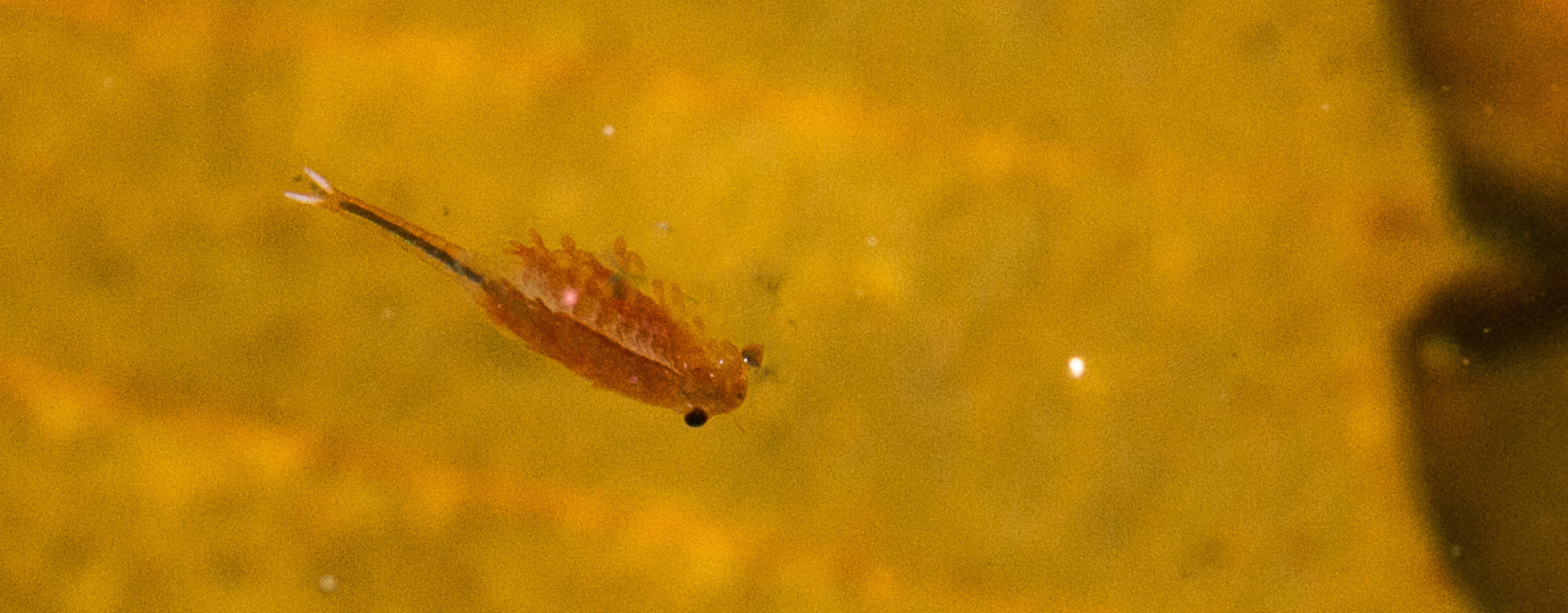An encounter with fairy shrimp is one of the great joys of visiting a woodland vernal pool. These small, shrimp-like crustaceans are as ephemeral as some orchids—appearing in abundance one year, and not at all the next. In addition, when they do appear, the active phase of their life cycle is short-lived (lasting only a couple weeks), so timing is critical if you want to catch a glimpse of these poorly-understood and engaging invertebrates.
Lacking any dispersal mechanism of their own, fairy shrimp are permanent residents of temporary pools. We can only assume they are dispersed inadvertently by other animals, such as waterfowl and amphibians, or by wind and flooding events. Worldwide there are some 300 species found scattered across all seven continents, with 64 known in North America. Generally about ¾-inch long, fairy shrimp are easily recognized by their combination of stalked eyes, “upside-down” swimming behavior, and often orange, reddish, bronze, or bluish coloration. Fossils of fairy shrimp date back to the Cambrian Period (more than 500 million years ago), long before the first fish introduced simple vertebrate anatomy to the world. Originally populating the world’s oceans, fairy shrimp were eventually forced by evolving predators into shallow, temporary freshwater habitats.
In New England, at least two species of fairy shrimp are found inhabiting vernal pools–the Vernal Fairy Shrimp (Eubranchipus vernalis) is fairly widespread in southern New England, while further north it is replaced by the Knob-lipped Fairy Shrimp (E. bundyi). This reddish-orange fairy shrimp is most often seen in early spring, shortly after ice-out. Although little is known about the distribution and abundance of the Knob-lipped Fairy Shrimp in Vermont and New Hampshire, anecdotal evidence suggests that they prefer larger pools located in relatively undisturbed forest to roadside pools or other “disturbed” habitats.
After fertilization, fairy shrimp eggs—technically called cysts—settle to the bottom of the pool where they enter a state of diapause. Resistant to desiccation, the cysts remain in the sediment throughout the summer when most vernal pools dry up. Cysts (which are fully-developed embryos) provide a great advantage over eggs when an organism lives in a quickly disappearing habitat like a drying vernal pool. The embryo can emerge as soon as conditions are right for hatching, which tend to be specific for each species (or even population), including a narrow temperature range with sufficient light and oxygen levels, combined with low osmotic conditions. In addition, studies of some fairy shrimp species have demonstrated reduced hatching success when cysts are not exposed to pool-drying and/or freezing temperatures. This may explain why, after being present in a given pool for several years, fairy shrimp may “disappear” for a year or two, only to suddenly reappear one spring for no apparent reason.
Since there is always a risk that a dry spring would not fill a pool long enough for fairy shrimp to complete their reproductive cycle, they have evolved a unique bet-hedging strategy to avoid extirpation. In any given year, only a portion of the previous year’s cysts will hatch, resulting in a “bank” of dormant eggs that can last for decades, possibly even centuries! One study of vernal pool sediments reported 1,000 cysts per square foot, of which only 3% hatched during any given flooding event. Such bet-hedging ensures that it would take a long series of false starts and unfavorable conditions to empty the cyst bank that rests below the leaf litter.
In our region, Eubranchipus eggs hatch in late winter or early spring as well-developed larvae called “metanauplii”. After several molts (instars), they add appendages and, over the course of 1-2 weeks, gradually mature into adults with the full complement of 11 pairs of feathery legs. Adult male bundyi appear to patrol territories, waiting for receptive females to approach them. Mature females, which tend to remain hidden in the leaf litter, can be recognized by paired egg sacs located just behind their feathery legs, while mature males appear to have enlarged heads due to the presence of claspers–modified antennae used to grasp females during mating.
The adult life cycle is fleeting—lasting only 1-3 weeks. Once the water temperature approaches 60 degrees F, usually by mid- to late-May, fairy shrimp populations decline rapidly. As oxygen levels decline and predators, such as dragonfly and salamander larvae, increase in both abundance and size, conditions become increasingly inhospitable for these slow-swimming crustaceans.
Vernal pools are critical components of healthy forest ecosystems in the Northeast, and fairy shrimp—which spend their entire lives in these tiny wetlands—are indicators of vibrant, unpolluted systems. Do yourself a favor and visit a vernal pool in your neighborhood this spring. If you’re lucky, perhaps you’ll become acquainted with these intriguing crustaceans.
Photo Credit: Banner photo by Josh Lincoln

